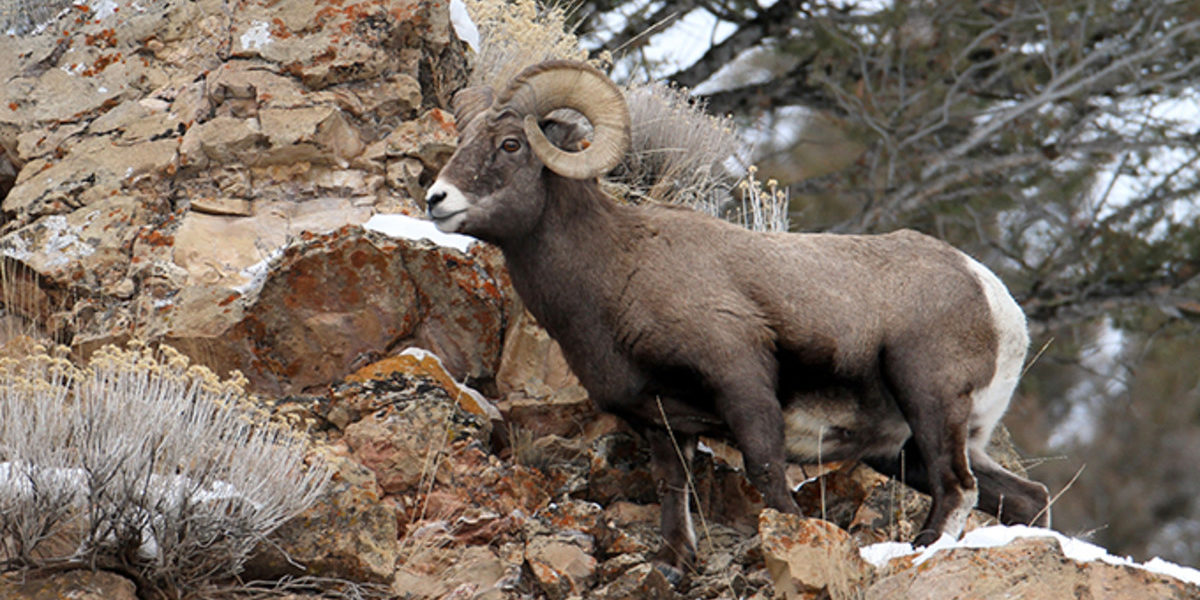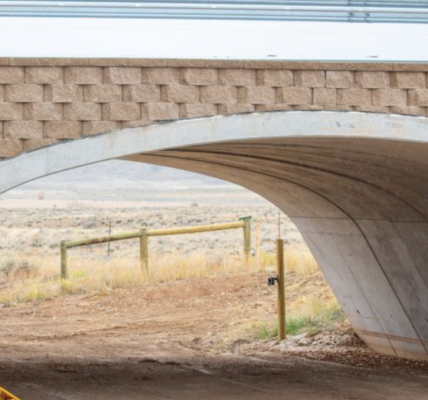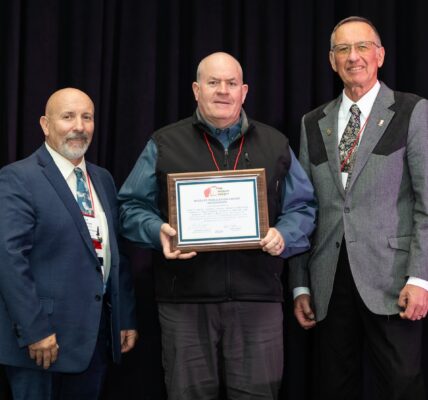By Angus M. Thuermer Jr., WyoFile.com
Domestic sheep could graze anew on national forest land in the Wyoming Range where conservationists bought grazing rights to separate them, their pathogens and their impacts from bighorn sheep and their habitat.
The Bridger-Teton National Forest is proposing to allow domestic sheep “restocking” by amending its management plan. It is seeking input by June 7 on issues it should address.
The proposed change tilts on the fulcrum of a Wyoming outline that specifies which wild bighorn herds are “core-native” herds prioritized for conservation and which are “non-emphasis” populations. Wyoming characterizes bighorn herds in the northwest as core but relegates those in the Wyoming Range to the lesser status.
At issue is whether federal guidelines governing wildlife on the Bridger-Teton National Forest call for protecting the Wyoming Range bighorns or whether the state plan will prevail. The conflict arises, in part, from pathogens domestic stock spread to bighorns, which are susceptible to pneumonia and other ailments that can drastically cut their numbers.
Bighorns in the Wyoming Range “exist at their own peril,” Wyoming Stock Growers Association Executive Vice President Jim Magagna said, summarizing the Wyoming Bighorn/Domestic Sheep Plan — a 17-year-old multi-stakeholder compromise. “They’re certainly welcome to be there,” he said, “but [the Forest Service] would not close any [domestic] sheep [grazing] allotments because of that particular [bighorn] herd” if federal managers honor the state plan and its non-emphasis designation.
However, the Bridger-Teton, which encompasses the Wyoming Range, “has an obligation to provide viable [wildlife] habitat,” said Kit Fischer, the National Wildlife Federation’s director of wildlife programs, who worked to buy out thousands of acres of grazing permits in the range. He’s fearful the federal agency may argue “we don’t have to protect every herd on the forest,” he said.
Bighorns were native to the Wyoming Range but by the early 1960s “competition with domestic sheep and illegal harvest were believed responsible for their extirpation,” Wyoming Game and Fish Department biologists have said.
The state wildlife agency reintroduced bighorns to their once-native Wyoming Range habitat around Mount Darby, 10,651 feet, in 1981 and 1987. To protect them from disease, the Bridger-Teton Forest Plan adopted a “standard” in 1990 that says domestic sheep “will not be restocked” on grazing allotments that become vacant there.
But the Wyoming Bighorn/Domestic Sheep Plan, forged some 14 years later in 2004, distinguished between core-native bighorn herds that had persisted in their historic ranges and those, like the Darby Herd, that had been extirpated and re-established.
Participants crafting the state bighorn/domestic sheep plan — four federal land managers, four Game and Fish employees, three agriculture representatives, six domestic sheep grazing permittees or producers, three conservationists and two elected politicians — relegated the Darby Herd and others to “non-emphasis” status.
The group designated the Jackson North, Jackson South, Whiskey Mountain, Targhee and Absaroka herds as core natives, but the Bridger-Teton has not adopted protective standards for those bighorns.
In addition to stripping the Darby Herd of its no-restocking protection, the proposed forest plan amendment would impose the no-restocking standard to protect the core-native areas on the Bridger-Teton for the first time.
Given the Wyoming bighorn/domestic framework, it’s unlikely domestic sheep grazing would be allowed on federal lands around the core Bridger-Teton bighorns even without the new protections, but not impossible.
“We’re very supportive,” Magagna said of the proposed forest-plan change, “as the Wyoming plan calls for protecting the native bighorn herds.” The proposal change “puts the Forest Service plan right on board with the state bighorn sheep/domestic plan,” he said.
The change could leave the Darby Herd at risk, the Bridger-Teton acknowledges.
“We know that disease outbreak is a threat to bighorn sheep herds and separation of bighorn sheep from domestic sheep and goats [is] an important management tool for the Forest,” Deputy Forest Supervisor Kevin Khung said in a statement.
The Forest Service has thus far protected the Darby transplants because “Game and Fish thought that was a high-priority herd,” said Steve Kilpatrick, a biologist representing the Wyoming Wild Sheep Foundation. “That’s the reason for the [will not be restocked] wording in the [1990] Forest Plan.”
In recent decades, conservationists paid domestic sheep herders to vacate many grazing permits and allotments in the Wyoming Range. All told, conservationists bought out more than 124,000 acres of domestic sheep grazing permits in the Wyoming Range.
“Nobody’s pushing permittees out,” said Fischer of the National Wildlife Federation office in Montana. Permittees often come to his organization because of conflicts, he said.
“We’re not anti-grazing, we’re anti-conflict,” he said. “We feel if we can convert allotments to cattle where it’s suitable, we’ll see far fewer instances of conflict.”
Fischer’s group and other conservation organizations, including Trout Unlimited, the Rocky Mountain Elk Foundation, the Wyoming Wild Sheep Foundation, the Trust for Public Lands and the Wild Sheep Foundation, paid fair-market value for the buyouts, he said. Game and Fish set a goal of 150 bighorns in the range. The population climbed to more than 60.
But things began shifting in 2015. That year the Legislature adopted Wyoming’s Bighorn/Domestic Sheep Plan as law, Kilpatrick said. But lawmakers that year also acted against any further curtailment of domestic sheep grazing in the Wyoming Range.
Legislators easily passed a measure allocating $37,500 to the Game and Fish — available through 2020 — “for removing or relocating the Darby Mountain bighorn sheep herd from the Bridger-Teton National Forest boundaries.” Game and Fish would remove or relocate the wildlife if “any federal judicial or agency action require[ed] the elimination or suspension of any domestic sheep grazing in the Wyoming Range…”
One lawmaker called the measure blackmail. Game and Fish the next year changed the population goal for the Darby Herd from a “population objective” of 150 to a “trend-count” objective, a slightly different method of counting, of 65.
Magagna cited work on the Wyoming Bighorn/Domestic Sheep Plan as critical in building support for stock growers. A consortium of interests worked for years to develop the state’s vision for core native and non-emphasis herds, he said.
“We’ve encouraged the Forest Service to follow that,” he said. So did the Wyoming Department of Agriculture, which “has been in contact with the U.S. Forest Service over the years on bighorn sheep/domestic sheep management on the forest,” agency spokesman Derek Grant said in a statement.
Engagement sought “to encourage the management of bighorn sheep according to the Statewide Bighorn/Domestic Sheep Interaction Working Group plan which is in Wyoming rule and statute,” Grant wrote.
Agricultural interests laid the foundation for the state’s plan, said Erik Molvar, executive director of Western Watersheds Project, a group critical of public lands grazing. The Wyoming planning group declared the Darby Herd “as essentially sacrificial and not worthy of conservation,” he said.
Under today’s Bridger-Teton management scheme, “the Forest Service isn’t really allowed to sacrifice the Darby Herd,” he said. “That’s why they need a plan amendment.
“It’s important to note,” Molvar said, “the Forest Service is in no way bound by state plans and wildlife management policies.”
Game and Fish takes the risk of disease transmission from domestic sheep to bighorns seriously. So much so that when a Thermopolis-based rancher moved domestic sheep to private land on the edge of the state’s largest bighorn herd — the Absaroka Herd of more than 4,500 bighorns in the Cody region — the agency sprang into action.
Gov. Mark Gordon authorized an emergency hunt in August 2020 targeting up to 34 bighorns in Hot Springs County’s Owl Creek drainage. Unlike most bighorn hunts that focus on mature rams, the emergency decree targeted any bighorn — ram, ewe or lamb.
None were killed there last year, Game and Fish’s Bart Kroger said, citing agency harvest records. The agency approved a 2021 season of 32 bighorns of any age or sex in August “to allow harvest in an area where there is potential overlap between domestic and wild sheep.”
Disease transmission is a worry, too, for Grand Teton National Park, home of the Targhee Herd, where wildlife managers counted 90 sheep in 2020. Mountain goats, introduced by wildlife managers in Idaho, have moved into Wyoming and the national park, threatening the core native bighorns in the iconic Teton Range.
Grand Teton launched a controversial aerial goat shoot in 2020 before Wyoming objections halted the operation. The Park Service then allowed hunters to target goats, the state’s preferred method for the cull.
There’s no evidence that the Darby Herd has an interchange with the larger Jackson Herd to its north, Kilpatrick said, perhaps reducing worries that disease introduced to bighorns in the Wyoming Range might spread to their neighbors — some 500 strong — in the Gros Ventre mountains.
“The limited data so far does not show interchange between animals in the southern part of the Jackson Herd and the Darby Herd,” he said, but more research is needed.
Fischer said conservationists’ buyouts were calculated. “We had our eyes wide open,” he said. “We have to rate the risk on all of these investments.”
The buyouts “bought a tremendous amount of grazing relief,” Kilpatrick said. “Plants are coming back because of these buyouts,” he said. “We’ve learned you can’t graze those [habitats] hard.”
The Bridger-Teton could give Darby bighorns another level of protection by declaring them a species of conservation concern, something other national forests have done. Regardless of that designation, which Fischer said would be politically fraught, the Forest Service would still need to do additional environmental review before domestic sheep could graze in the buyout allotments under the proposed plan change, he said.
“We believe there’s enough evidence [that] it could be very challenging for the forest to restock those allotments,” he said. The question that remains, he said, is whether “the good that could come out of this amendment” — protection for core-natives — “is greater than the risk of potential restocking.”
People who want to comment on the range of issues the Forest Service will address in its proposed amendment can do so electronically through June 7 on the Forest webpage at https://www.fs.usda.gov/







